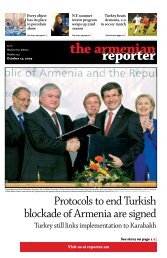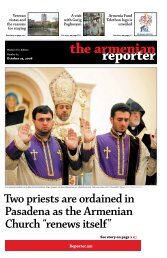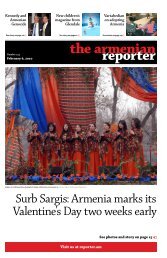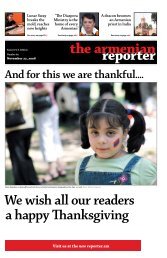Leading lady Karen Kondazian - Armenian Reporter
Leading lady Karen Kondazian - Armenian Reporter
Leading lady Karen Kondazian - Armenian Reporter
You also want an ePaper? Increase the reach of your titles
YUMPU automatically turns print PDFs into web optimized ePapers that Google loves.
Earthwork collage<br />
and installation.<br />
Marcos Grigorian<br />
in his earthwork<br />
sculpture might<br />
add a freestanding,<br />
labor-worn tool to<br />
his composition,<br />
a barrow, wood<br />
plough, or a rake<br />
that seems to<br />
have scratched<br />
the earth for<br />
generations.<br />
of a flame. One sleepless night in<br />
distant thunder and light rain, I<br />
walked in the park and first came<br />
upon the monument. There was a<br />
spotlight on a further high pole<br />
giving a focused shaft of light on<br />
the brass object. The brass object<br />
seemed to flicker in high flame<br />
and into the pattern of the steady<br />
rain in that shaft of light an autumn<br />
leaf twisted and glowed for<br />
a moment in its fall to the ground.<br />
I was moved by this, and looking<br />
with wet eyes saw that on the<br />
ground were spread bouquets of<br />
cut flowers – like Martiros Sarian’s<br />
great, iconic homage to the dead<br />
of the Great War that hangs in the<br />
National Galleries, and I stood in<br />
silent awe. This small stone split<br />
at the top into two parts at this<br />
small spot had been made sacred<br />
in commemoration of both<br />
the Genocide and the Holocaust.<br />
Words were not needed to feel and<br />
know this truth.<br />
Grigorian, however, had larger<br />
ambitions. To create his own vision<br />
of the murder of innocents at Auschwitz,<br />
Marcos Grigorian turned, I<br />
believe, to a most unlikely source:<br />
paintings of the martyrdom of<br />
Hussein in the popular culture<br />
of Persia – part of the mournful<br />
story of Ashura, whose recitation<br />
was capable of bringing tears of<br />
compassion and floods of sorrow<br />
to millions of Shia Muslims.<br />
Talismans against the Evil Eye. These are embroidered sun disks with female faces,<br />
called Sun Ladies. They suggest a Zoroastrian or even earlier origin, calling upon the<br />
powers of the goddess Anahita to protect the children in the family. The Grigorian<br />
Collection contains especially fine examples. It is a cultural tradition that deserves<br />
additional study.<br />
Reza Shah had banned the selfflagellation<br />
of the Ashura processions<br />
in Iran, as later would<br />
Saddam Hussein in Iraq. The selfflagellation<br />
created a sense of an<br />
oppressed community profoundly<br />
united in shared pain. In what was<br />
then a severely constricted tradition,<br />
Marcos had salvaged what<br />
remaining paintings he could find<br />
and commissioned new traditional<br />
artwork by what he called the<br />
Teahouse Troubadours, the itinerant<br />
storytellers who went from<br />
teahouse to teahouse in their<br />
singing voices carrying a painted<br />
scene of the tragedy at Karbala<br />
that would illustrate the major<br />
elements of the martyrdom as it<br />
unfolded.<br />
If the Ashura paintings would<br />
provide Marcos with an inspired<br />
starting point, he could also find<br />
ample evidence of similarities in<br />
the Christian tradition, notably<br />
the ritual processions of penitents<br />
down the Via Dolorosa. Nor<br />
is there any lack of deeply moving<br />
Jewish folkloristic art on the<br />
theme of the suffering and sorrow<br />
of a persecuted people set apart.<br />
But wherever he might find antecedents,<br />
unavoidable would be<br />
comparison to the most successful<br />
painting ever done of a large-scale<br />
human tragedy in the 20th century:<br />
Picasso’s 1937 masterwork,<br />
Guernica, painted in the heat of<br />
the moment. It succeeded in no<br />
small part because the painting<br />
talked to sentiments already mobilized<br />
and orchestrated.<br />
Picasso used a huge canvas,<br />
more than 10 feet high and more<br />
than 26 feet long, giving a visceral<br />
immediacy and the urgency of a<br />
black-and-white news sheet to<br />
the aerial bombing of a defenseless<br />
city and the deliberate killing<br />
of men, women, and children that<br />
was to later become a too-familiar<br />
tactic of modern, total war. Guernica<br />
was the capital of the shortlived<br />
Basque Republic in the Spanish<br />
Civil War, razed by Hitler’s aircraft<br />
as a gesture of friendship at<br />
the request of the fascist Franco<br />
regime.<br />
Auschwitz touches human catastrophe<br />
in a way that is vastly<br />
more intimate, troubling, and on<br />
the greatest scale the world had<br />
ever known. Moreover, while Auschwitz<br />
belongs to all of us, whatever<br />
the pressing reasons Grigorian<br />
would do this at that time,<br />
they are his own. Picasso painted<br />
on one huge panel. Marcos Grigorian<br />
needs more space: he needs<br />
at least a dozen huge panels to tell<br />
a narrative with a beginning and<br />
an end. He took Picasso’s 10-foothigh<br />
canvas and in smaller segments,<br />
laid them on their sides,<br />
so that each of 12 panels is 6 feet<br />
high and 10 feet long His finished<br />
work, completed in 1959, is more<br />
than 120 feet in length.<br />
The sad fact is that this museum<br />
contains only two of the panels of<br />
The Gate of Auschwitz, a fraction<br />
of the entire work. It has neither<br />
C8 <strong>Armenian</strong> <strong>Reporter</strong> Arts & Culture 10/20/2007

















